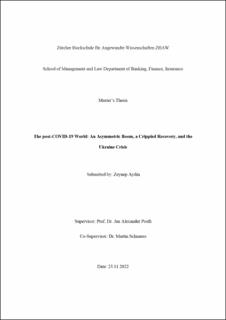Please use this identifier to cite or link to this item:
https://doi.org/10.21256/zhaw-29250Full metadata record
| DC Field | Value | Language |
|---|---|---|
| dc.contributor.advisor | Posth, Jan-Alexander | - |
| dc.contributor.advisor | Schnauss, Martin | - |
| dc.contributor.author | Aydin, Zeynep | - |
| dc.date.accessioned | 2023-12-01T16:01:24Z | - |
| dc.date.available | 2023-12-01T16:01:24Z | - |
| dc.date.issued | 2022 | - |
| dc.identifier.uri | https://digitalcollection.zhaw.ch/handle/11475/29250 | - |
| dc.description.abstract | This paper aims to define the early post-COVID-19 era and answer the following research question; What are the influences of the Ukraine crisis on inflation in Europe from the perspective of the post-COVID-19 global financial world? The research is taken in two steps. The first step involved a detailed analysis of reports from international financial institutions and a detailed literature review. In the second step, interviews were taken with sector professionals. For analyzing the interview outcomes, qualitative content analysis was chosen as a method. | de_CH |
| dc.description.abstract | The COVID-19 pandemic and stringent controls have impeded businesses' and consumers' production ability. In response to economic disturbances, several governments deployed enormous fiscal stimulus. This method increased consumption, which, when paired with a somewhat inelastic supply, resulted in supply chain bottlenecks and pricing pressures. Nonetheless, extensive public assistance was beneficial during this extraordinary crisis. Despite the potential for pricing pressures due to the investment, the enormous spending aided a solid economic rebound. As a result, GDP and employment rebounded historically, perhaps avoiding catastrophic effects. On top of this distorted economy, the war between Ukraine and Russia has put Europe under a severe energy crisis and an inflationary atmosphere. The European sanctions on Russia and the region's reliance on Russian imports for energy and industrial items have put pressure on the regional economy. These sanctions and the conflict caused a raw material scarcity and an energy crisis in Europe, resulting in an inflationary climate. Thus, while the epidemic and the Russia-Ukraine war are not the same types of disaster for Europe, they are both foreign shocks. As a result, they drive EU choices and develop various policies. This study aims to focus on the post-COVID-19 global financial landscape. A detailed literature review and reports from global institutions such as the International Monetary Fund (IMF), the World Bank, the Organization for Economic Cooperation and Development (OCED), and the European Central Bank (ECB) were analyzed to determine the results. In the second phase, interviews were conducted with senior financial sector experts, senior economists, investment advisors, journalists, and policy advisors to provide insights. Qualitative content analysis was used to analyze the interviews. This was done by transcribing the interview data, rereading it and highlighting the essential parts in yellow, creating codes where necessary, and analyzing them by grouping them under headings. The interviews suggest that the foundations for a faster response to future crises should be laid, and the private sector should be included in this infrastructure. When developing the rules for this new era, the business world should be brought together and planning should be done by taking into account the necessary risk assessments. For this, it is essential to examine the obstacles the economy has faced since 2019, with the pandemic that started in Wuhan and has affected the whole world and deepened with the war between Ukraine and Russia. This paper describes how the global economy has been shaped by the COVID-19 pandemic and the war in Ukraine and provides a summary for future research that seeks to contribute to the literature on macroeconomics, structural reforms, and political economy. | de_CH |
| dc.format.extent | 79 | de_CH |
| dc.language.iso | en | de_CH |
| dc.publisher | ZHAW Zürcher Hochschule für Angewandte Wissenschaften | de_CH |
| dc.rights | https://creativecommons.org/licenses/by-nc-nd/4.0/ | de_CH |
| dc.subject | COVID-19 | de_CH |
| dc.subject | Ukraine crisis | de_CH |
| dc.subject | Inflation | de_CH |
| dc.subject | Europe | de_CH |
| dc.subject | Supply chain | de_CH |
| dc.subject.ddc | 332: Finanzwirtschaft | de_CH |
| dc.title | The post-COVID-19 world : an asymmetric boom, a crippled recovery, and the Ukraine crisis | de_CH |
| dc.type | Thesis: Master | de_CH |
| dcterms.type | Text | de_CH |
| zhaw.departement | School of Management and Law | de_CH |
| zhaw.publisher.place | Winterthur | de_CH |
| dc.identifier.doi | 10.21256/zhaw-29250 | - |
| zhaw.originated.zhaw | Yes | de_CH |
| Appears in collections: | MSc Banking and Finance | |
Files in This Item:
| File | Description | Size | Format | |
|---|---|---|---|---|
| 2022_Aydin_Zeynep_MSc_BF.pdf | 22.54 MB | Adobe PDF |  View/Open |
Show simple item record
Aydin, Z. (2022). The post-COVID-19 world : an asymmetric boom, a crippled recovery, and the Ukraine crisis [Master’s thesis, ZHAW Zürcher Hochschule für Angewandte Wissenschaften]. https://doi.org/10.21256/zhaw-29250
Aydin, Z. (2022) The post-COVID-19 world : an asymmetric boom, a crippled recovery, and the Ukraine crisis. Master’s thesis. ZHAW Zürcher Hochschule für Angewandte Wissenschaften. Available at: https://doi.org/10.21256/zhaw-29250.
Z. Aydin, “The post-COVID-19 world : an asymmetric boom, a crippled recovery, and the Ukraine crisis,” Master’s thesis, ZHAW Zürcher Hochschule für Angewandte Wissenschaften, Winterthur, 2022. doi: 10.21256/zhaw-29250.
AYDIN, Zeynep, 2022. The post-COVID-19 world : an asymmetric boom, a crippled recovery, and the Ukraine crisis. Master’s thesis. Winterthur: ZHAW Zürcher Hochschule für Angewandte Wissenschaften
Aydin, Zeynep. 2022. “The Post-COVID-19 World : An Asymmetric Boom, a Crippled Recovery, and the Ukraine Crisis.” Master’s thesis, Winterthur: ZHAW Zürcher Hochschule für Angewandte Wissenschaften. https://doi.org/10.21256/zhaw-29250.
Aydin, Zeynep. The Post-COVID-19 World : An Asymmetric Boom, a Crippled Recovery, and the Ukraine Crisis. ZHAW Zürcher Hochschule für Angewandte Wissenschaften, 2022, https://doi.org/10.21256/zhaw-29250.
Items in DSpace are protected by copyright, with all rights reserved, unless otherwise indicated.